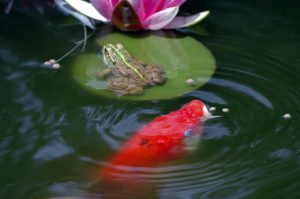Five basic steps to creating your own Koi pond are planning, digging, installing the pond liner and protective underlay, adding the bottom drain plus pond pump and filter, filling with water and finally adding your Koi.
Planning your Koi pond build
When you are looking for a site for your pond, start close to the house. There is little point in spending a lot of money on a pond full of beautiful fish if you have to trek up to the end of the garden to see them.
Think about where the sun falls in your garden and avoid siting your pond where it will be in full shade – especially during winter. Avoid trees as fallen leaves may clog and pollute the water if not skimmed off. And, the roots could cause serious damage to your pond liner. Full daily sun is also to be avoided as it may result in an increase in algae growth. Don’t forget, you will need to get an electrical supply to your pond, so think about cable runs and siting.
Then plan the size and shape of your pond. Koi ponds should ideally be at least 1 meter deep and up to 1.5m wide or hold 1500 gallons of water. Koi are big fish and need a space to move about in. They also produce large amounts of waste. For both those reasons, a steep or vertical sided pond is recommended. It guarantees the largest volume of water for the space occupied by the pond. Steep sides don’t accumulate waste materials and debris that can release harmful ammonia. 
Keep the design of your Koi pond simple. The simpler the shape – round, oval or rectangular – the easier it is to maintain. A simple shape can always be disguised by creating border features with stones, rocks and plants – bear this in mind when purchasing your pond liner and underlay as both will need to extend beyond the limits of your border features.
Digging the hole for your pond
Unless your pond is going to be built above ground, you are going to be shifting a lot of soil even for a modestly sized pond – so consider hiring a mini digger. It will save you time and effort (and blisters). Before you start digging, mark out the shape using a rope or hosepipe.
Once the pond is dug to the right size and depth, create the channels for the bottom drain, the connecting pipe work (usually 110mm), as well as returning pipe work from the filtration system.
The bottom of your vertically sided pond should slope gently towards the bottom drain.
Installing the pond liner
Now your box-welded pond liner and protective underlay can be installed. The best underlay is a tough, durable 0.5mm geotextile made from mechanically bonded polypropylene. It will not only protect the pond liner from physical damage, but will also allow any gases that build up underneath the pond liner to escape. Your box-welded pond liner should have an overlap of 20-30cms to extend over the top of your pond securing it in place. Put soil, gravel, rocks or boulders on to the overlay to anchor your pond liner securely in place.
Because Koi ponds tend to be deep, steep sided and regularly shaped, consider ordering a box-welded liner in either Epalyn (EPDM) or butyl made to the precise dimensions of your pond. It is worth waiting until your construction is complete so that you can measure the actual dimensions. Box-welded pond liners are much simpler to install. If measured correctly, it will provide a smooth lining without wrinkles and folds which can trap waste matter.
Adding the right equipment to create a healthy ecosystem
Making sure that your Koi pond is properly equipped with the necessary water filtration and cleaning systems is critically to the success of your venture. The ideal set-up will use a gravity feed from the bottom drain taking the water and waste to a filtration system, which will consist of a settling chamber, where the majority of the large solids are removed; a mechanical filter, which will strain even the smallest particles; and finally a biological filter where good bacteria are encouraged to consume chemicals such as nitrites and ammonia. In natural conditions there is sufficient water volume and surface area for bacteria to maintain a healthy balance in the water. But in an artificial pond, where the ratio of fish to water is much higher than in nature, you must provide additional space for good bacteria to do their work.
Koi pond finishing touches
Before adding Koi fish to your pond, busy yourself sorting out the borders and adding plants.
And finally….
A week after adding water to your pond, you can begin to add fish gradually monitoring the water conditions as you go. When you bring the fish home from a specialist Koi stockist, they need to be acclimatised both to the water temperature and pond conditions. So, to begin with, open the bag, fixing it to the side of the pond and leave it floating for half an hour or so. Avoid doing this in direct sunlight. Then start to add a little pond water into the bag gradually over the next hour and finally release your Koi friends into their new home.





